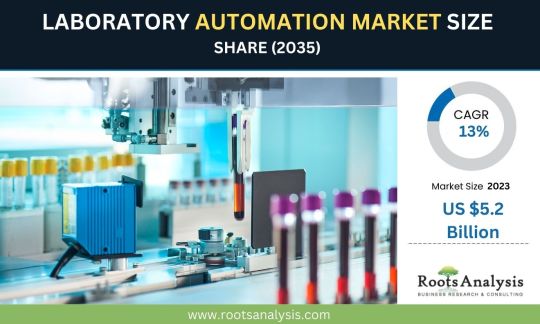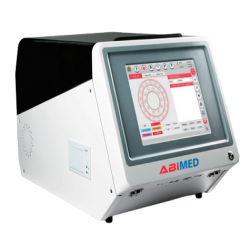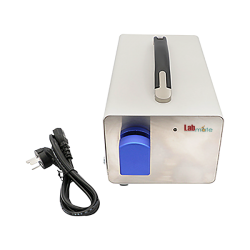#Laboratory Automation
Text

Laboratory Automation Market Size | Forecast Period | Share & Size (2035)
The global lab automation market (size) report is estimated to be USD 5.2 billion in 2022 and grow at an annualized rate (CAGR) of 13%. The Roots Analysis report features an extensive study of the current market landscape and the future potential of the lab automation market over the next 12 years. Get a detailed insights report now!
0 notes
Text
Optimizing Your Scientific Workflow With Data And Informatics Consulting
Do you want to optimize your scientific workflow? It can be a daunting task, but with the help of data and informatics consulting, it doesn't have to be. Data and informatics consulting provides the expertise and experience you need to ensure your research is as efficient and effective as possible. In this article, we'll explore how data and informatics consulting can help streamline your scientific workflow.
Data and informatics consulting involves using technology to analyze data quickly and accurately. With the right tools, consultants can identify patterns in large datasets that might otherwise go unnoticed. This means they can spot potential problems before they become major issues, saving time and money in the process. Furthermore, these professionals have an in-depth understanding of how different systems interact with one another, allowing them to develop optimal solutions for complex processes.
Finally, data and informatics consulting can provide invaluable insights into ways to improve your scientific workflow. From identifying areas where efficiency improvements can be made to finding new ways to save time on complex tasks, these professionals are essential for any research team looking to streamline their operations. So don't hesitate - leverage the power of data and informatics consulting today!
Definition Of Scientific Workflow
Scientific workflows involve the combination of data and techniques to create new knowledge. It's an iterative process that starts with a research question, then moves through data collection and analysis, to finally ends with presenting findings. Each step of the workflow requires careful planning and execution.
Data management is integral to scientific workflows. Data must be collected, organized, analyzed, stored, and shared in order for meaningful results to be obtained. This means that efficient data management practices must be used throughout the workflow process. In addition, data must be kept secure and protected from unauthorized access or manipulation.
Informatics consulting can help optimize a scientific workflow by providing expertise in data management, analysis techniques, software tools, and more. With the right team of experts on board, scientists can streamline their workflows and gain insights faster than ever before.
Benefits Of Optimizing It
Now that we have a clear understanding of what scientific workflow is, let's explore the advantages of optimizing it.
Firstly, optimizing your scientific workflow can help you save time. This is because data and informatics consulting services can help you simplify complex processes and increase the accuracy of analysis results. By having an efficient workflow, scientists are able to quickly identify trends in their data and generate actionable insights. Furthermore, they can automate tedious tasks that would otherwise take up valuable time and resources. This allows them to focus more on important projects and research goals.
Secondly, it helps to improve collaboration among scientists. Data and informatics consulting services allow teams to share information easily and securely, which increases the efficiency of communication between members. Additionally, it provides teams with a better way to track progress on their projects since everyone is working off the same platform. All this leads to greater engagement among team members, leading to better results overall.
Finally, it also helps reduce errors in data processing. Data and informatics consulting services provide access to advanced tools that make it easier for scientists to spot discrepancies or inaccuracies in their data sets before making decisions based on them. This ensures that all data used for analysis is accurate and reliable, leading to improved outcomes from experiments or studies. Ultimately, by using these services, scientists can be confident in the accuracy of their findings while also reducing the risk of mistakes being made due to inaccurate data processing.
The Role Of Data And Informatics Consulting
Data and informatics consulting can play an invaluable role in optimizing scientific workflows. Their expertise can help streamline processes, leading to greater efficiency, accuracy, and effectiveness. Firms specializing in this field have the experience and understanding of the latest technology to ensure that scientists are able to utilize their data effectively.
They can advise on a range of issues from data collection to storage, analysis, visualization, and reporting. Additionally, they provide guidance for the implementation of analytics tools such as machine learning and artificial intelligence. Ultimately, this helps scientists make more informed decisions based on deeper insights into their data sets.
Data and informatics consulting firms are also well-positioned to create custom solutions tailored to an organization's specific needs. By leveraging their knowledge of data science methods and technologies, these consultants are able to develop innovative solutions that enable organizations to maximize their data’s potential. This allows scientific teams to focus on research objectives rather than dealing with tedious technical tasks related to managing data.
The right data and informatics consulting partner can be a powerful ally in optimizing workflows for any scientific organization or team. With their help, organizations can improve their efficiency while gaining deeper insight into their datasets and making better decisions based on this information.
Analyzing Your Current Workflows
Now that you understand the role of data and informformatics consulting in optimizing your scientific workflow, it's time to analyze your current workflows. Understanding how you currently approach research and what processes are working is key to understanding where improvements can be made.
The first step in analyzing your current workflows is to document all the steps involved in each project. This will help identify which steps are crucial to a successful outcome and which could use some optimization. After documenting the process, assess how much time each step takes and look for any redundancies or areas where processes can be streamlined. Once you have identified those areas, determine if automation could save time and improve productivity.
Finally, evaluate how secure your existing systems are by looking at access controls and data security protocols. With this information, you'll be able to create a plan for improving your overall efficiency while still maintaining important security measures.
Identifying Opportunities For Improvement
The first step in optimizing your scientific workflow with data and informatics consulting is to identify opportunities for improvement. To do this, you must analyze your current methods and processes, create an inventory of key tools and technologies, and assess the effectiveness of each component.
When evaluating your existing workflow, look for areas where processes are inefficient or outdated. Are there steps that can be automated? Is there a need to integrate additional software solutions or new data sources? Are there any manual processes that could be streamlined? Make a list of any issues that need to be addressed and prioritize them according to their importance.
Once you have identified potential improvements, it’s time to start implementing solutions. Develop a plan for making changes, such as introducing new technologies or streamlining existing processes. Outline the resources required for each step and set realistic timelines for completion. By taking the time to identify opportunities for improvement and develop an actionable plan, you can ensure your scientific workflow is optimized for success.
Automating Processes
Having identified where improvements can be made, the next step is to consider how to automate processes in order to optimize your scientific workflow. Automation has the potential to reduce cost and time while increasing efficiency and accuracy.
To begin automating processes, it is important to understand what types of tasks are best suited for automation. Tasks that involve repetitive processes, such as data entry or data analysis, are good candidates for automation as they require minimal human intervention. Additionally, tasks that involve complex calculations or other computational processes may also be suitable for automation.
Once tasks have been identified, the next step is to determine which tools and technologies can help automate these processes. Data and informatics consulting can assist in this process by providing insights into the most effective technologies for automating specific tasks. These insights can include recommendations on software solutions and hardware platforms, as well as advice on how to configure systems for optimal performance. Automating processes with the right tools can ultimately lead to significant improvements in efficiency and cost savings.
Utilizing Cloud-Based Solutions
Cloud-based solutions are becoming increasingly popular for managing data and informatics in the scientific workflow. They offer a range of advantages that can help optimize the entire process. Firstly, cloud-based solutions offer a secure storage platform that is easily accessible from any device connected to the internet. It also helps eliminate the need for expensive hardware and IT support costs, as cloud-based solutions are typically priced on a monthly subscription basis with high scalability depending on your needs. Finally, they provide an easy way to share data with collaborators securely, enabling easy collaboration within research teams.
Data and informatics consulting can help organizations make the most of cloud-based solutions by providing expertise in areas such as setting up cloud infrastructure, migrating existing data, and implementing security measures to protect sensitive information. This kind of consulting is especially useful for companies looking to transition from traditional computing models to more modern methods of data management. Additionally, it can help streamline processes and ensure maximum efficiency for scientific workflows.
Cloud-based solutions provide many benefits which can be used to improve scientific workflow processes. Through careful planning and expert consultation, organizations can take advantage of these tools to maximize their productivity and achieve their goals more quickly and efficiently.
Leveraging Big Data Analytics
Data and informatics consulting can help streamline your workflow by leveraging big data analytics. This type of consultative approach can be used to identify trends, assess risks, and plan for more effective outcomes. With big data analytics, you get the insights you need to make decisions that will have an impact on the success of your scientific research.
The first step in leveraging big data analytics is to gather relevant data from multiple sources. This could include records from online databases, surveys, questionnaires, interviews and much more. Once this information is collected, it must be analyzed to uncover patterns or correlations that may exist between different factors. Using advanced algorithms and statistical methods, consultants can discover correlations between variables and gain insight into the underlying causes of certain phenomena.
This analysis of large datasets can enable researchers to determine which strategies are most effective in their research efforts. By combining this knowledge with predictive modeling techniques, scientists can develop strategies that maximize efficiency while minimizing costs and effort invested in their projects. In addition to this, big data analytics also provides detailed visualizations which allow researchers to monitor changes in their research over time and gain deeper understanding into the dynamics at play within their research studies.
System Testing And Validation
Having explored the potential of big data analytics, it's time to turn our attention to system testing and validation. To ensure that systems are functioning properly and producing accurate results, they must be tested extensively and verified with rigorous standards. This requires developing a comprehensive test plan that addresses all aspects of the system's functionality.
Systems should be tested in multiple environments, including development, staging, and production. Testing should include both functional and non-functional tests such as performance, scalability, security, reliability, usability, and compatibility tests. Additionally, automated tests can be used to supplement manual tests and identify any issues with system performance or data accuracy.
Once testing is complete and the system is validated for proper functioning, it can then be deployed for use. This process helps to ensure that systems are reliable and trustworthy before being put into active use. If done correctly, this process can optimize your workflow by eliminating any unforeseen errors or inaccuracies from occurring during production runs.
Continuous Monitoring And Maintenance
Continuous monitoring and maintenance of data and informatics systems is essential to ensure their efficient operation. Keeping these systems up-to-date with the latest software, hardware, and security patches can prevent costly issues down the road. There are a few steps that need to be taken to ensure that your scientific workflow is properly maintained.
First, data should be regularly backed up in order to protect it from potential loss or corruption. Regular backups also make it easier to restore data if any issues arise. Second, access control systems should be monitored closely so that users only have access to the information they need. Finally, system health checks should be conducted on a regular basis to identify any potential issues that could affect performance.
When done correctly, these steps can help guarantee smooth operation of data and informatics systems in your scientific workflow. Regular monitoring and maintenance also provides peace of mind knowing that your data is secure and performing optimally.
Conclusion
In conclusion, optimizing your scientific workflow with data and informatics consulting can be a great asset to any organization. It helps you identify areas for improvement and make necessary changes to keep up with the ever-changing field of science. By utilizing cloud-based solutions, leveraging big data analytics, conducting system testing and validation, and continuously monitoring and maintaining these systems, you can ensure that your scientific workflow is effective and efficient. With the help of an experienced data and informatics consultant, you can create a streamlined workflow that will save time, money, and energy while producing top-notch results. So if you're looking to get the most out of your scientific workflows, don't hesitate to contact a data and informatics consultant today!
#Scientific workflow#Data management#Informatics consulting#Research efficiency#Data analysis#Data visualization#Research collaboration#Data security#Laboratory automation#Data integration#Scientific reproducibility#Cloud computing#High-performance computing#Machine learning#Research data governance.
0 notes
Text

Whispering secret data.
#lab#machine#automation#robotics#cyberpunk#retro#scifi#stuck#laboratory#farm#android#cyborg#data#secret#whisper#illustration#drawing#digitalartwork#digitaldrawing#digitalart#digitalillustration#90s#cables#machinelearning#connection#ring#runner#net#flesh
2K notes
·
View notes
Text
Optimizing Lab Operations with Scientific Informatics Managed Services
In today's world, laboratories have become an essential part of various industries, including healthcare, pharmaceuticals, biotech, and environmental sciences. The growth of these industries has resulted in an increase in the number of laboratories, making lab operations management more challenging than ever before. It is crucial to optimize lab operations to ensure accuracy, safety, and efficiency in research and development. One way to do this is by leveraging scientific informatics managed services. In this article, we will discuss how scientific informatics managed services can help optimize lab operations and improve the overall efficiency of laboratories.
I. Introduction Laboratory operations have become increasingly complex due to advances in technology and the growing need for accurate data in various industries. The traditional approach to lab operations management, which involved manual processes and spreadsheets, is no longer effective. This has resulted in an increasing demand for scientific informatics managed services. These services use technology to automate and optimize lab operations, resulting in improved efficiency, accuracy, and safety.
II. What are Scientific Informatics Managed Services? Scientific informatics managed services are a suite of software tools and services designed to automate and optimize laboratory operations. They include laboratory information management systems (LIMS), electronic lab notebooks (ELN), laboratory execution systems (LES), scientific data management systems (SDMS), and many more. These tools and services provide an integrated approach to lab operations management, resulting in improved efficiency, accuracy, and safety.
III. Benefits of Scientific Informatics Managed Services Scientific informatics managed services offer several benefits to laboratories, including:
A. Improved Efficiency Scientific informatics managed services automate several manual processes, resulting in improved efficiency. These services provide an integrated approach to lab operations management, resulting in improved productivity, reduced turnaround times, and better resource utilization.
B. Increased Accuracy Scientific informatics managed services eliminate errors that occur due to manual processes, resulting in increased accuracy. These services ensure data integrity and traceability, resulting in high-quality data that can be trusted for decision-making.
C. Enhanced Safety Scientific informatics managed services ensure compliance with regulatory requirements, resulting in enhanced safety. These services provide electronic record-keeping and audit trails, ensuring that all actions are traceable and accountable.
D. Cost-Effective Scientific informatics managed services offer a cost-effective approach to lab operations management. They eliminate the need for manual processes, reducing labor costs, and improving resource utilization.
IV. How Scientific Informatics Managed Services Optimize Lab Operations Scientific informatics managed services optimize lab operations in several ways, including:
A. Sample Management Sample management is a critical aspect of lab operations, and scientific informatics managed services automate this process. These services provide an integrated approach to sample management, from sample registration to result reporting, resulting in improved efficiency, accuracy, and traceability.
B. Workflow Management Scientific informatics managed services provide an integrated approach to workflow management, resulting in improved efficiency, accuracy, and traceability. These services automate several manual processes, including task scheduling, execution, and reporting, resulting in improved productivity and reduced turnaround times.
C. Data Management Data management is a crucial aspect of lab operations, and scientific informatics managed services provide an integrated approach to data management. These services ensure data integrity and traceability, resulting in high-quality data that can be trusted for decision-making.
#Laboratory Informatics#Data Management#Scientific Data Analytics#Laboratory Automation#Laboratory Information Management System (LIMS)#Laboratory Workflow Optimization#Scientific Software#Scientific Data Integration#Scientific Data Visualization#Digital Transformation#Quality Control#Compliance Management#Scientific Research Management#Cloud Computing#Artificial Intelligence (AI)
0 notes
Text

Goretober #8 - Flesh & Steel
#dead philosophy's goretober 2023#goretober 2023#goretober#halloween#automation#employee of the month#laboratory equipment#surgery#october art challenge#october art prompts#art prompt#drawtober#dark art#horror art#dark illustration#traditional art#traditional drawing#traditional painting#traditional illustration#artists on tumblr#illustrators on tumblr#support human artists#goodnight everyone
34 notes
·
View notes
Video
youtube
Here’s music! Dexter’s laboratory song can you believe it!
#dexter's lab#dexter's laboratory#music#i know how to sample now. And pitch bend. And use automation tracks#i have too much power
5 notes
·
View notes
Text
Julie Shah named head of the Department of Aeronautics and Astronautics
New Post has been published on https://thedigitalinsider.com/julie-shah-named-head-of-the-department-of-aeronautics-and-astronautics/
Julie Shah named head of the Department of Aeronautics and Astronautics


Julie Shah ’04, SM ’06, PhD ’11, the H.N. Slater Professor in Aeronautics and Astronautics, has been named the new head of the Department of Aeronautics and Astronautics (AeroAstro), effective May 1.
“Julie brings an exceptional record of visionary and interdisciplinary leadership to this role. She has made substantial technical contributions in the field of robotics and AI, particularly as it relates to the future of work, and has bridged important gaps in the social, ethical, and economic implications of AI and computing,” says Anantha Chandrakasan, MIT’s chief innovation and strategy officer, dean of the School of Engineering, and the Vannevar Bush Professor of Electrical Engineering and Computer Science.
In addition to her role as a faculty member in AeroAstro, Shah served as associate dean of Social and Ethical Responsibilities of Computing in the MIT Schwarzman College of Computing from 2019 to 2022, helping launch a coordinated curriculum that engages more than 2,000 students a year at the Institute. She currently directs the Interactive Robotics Group in MIT’s Computer Science and Artificial Intelligence Lab (CSAIL), and MIT’s Industrial Performance Center.
Shah and her team at the Interactive Robotics Group conduct research that aims to imagine the future of work by designing collaborative robot teammates that enhance human capability. She is expanding the use of human cognitive models for artificial intelligence and has translated her work to manufacturing assembly lines, health-care applications, transportation, and defense. In 2020, Shah co-authored the popular book “What to Expect When You’re Expecting Robots,” which explores the future of human-robot collaboration.
As an expert on how humans and robots interact in the workforce, Shah was named co-director of the Work of the Future Initiative, a successor group of MIT’s Task Force on the Work of the Future, alongside Ben Armstrong, executive director and research scientist at MIT’s Industrial Performance Center. In March of this year, Shah was named a co-leader of the Working Group on Generative AI and the Work of the Future, alongside Armstrong and Kate Kellogg, the David J. McGrath Jr. Professor of Management and Innovation. The group is examining how generative AI tools can contribute to higher-quality jobs and inclusive access to the latest technologies across sectors.
Shah’s contributions as both a researcher and educator have been recognized with many awards and honors throughout her career. She was named an associate fellow of the American Institute of Aeronautics and Astronautics (AIAA) in 2017, and in 2018 she was the recipient of the IEEE Robotics and Automation Society Academic Early Career Award. Shah was also named a Bisplinghoff Faculty Fellow, was named to MIT Technology Review’s TR35 List, and received an NSF Faculty Early Career Development Award. In 2013, her work on human-robot collaboration was included on MIT Technology Review’s list of 10 Breakthrough Technologies.
In January 2024, she was appointed to the first-ever AIAA Aerospace Artificial Intelligence Advisory Group, which was founded “to advance the appropriate use of AI technology particularly in aeronautics, aerospace R&D, and space.” Shah currently serves as editor-in-chief of Foundations and Trends in Robotics, as an editorial board member of the AIAA Progress Series, and as an executive council member of the Association for the Advancement of Artificial Intelligence.
A dedicated educator, Shah has been recognized for her collaborative and supportive approach as a mentor. She was honored by graduate students as “Committed to Caring” (C2C) in 2019. For the past 10 years, she has served as an advocate, community steward, and mentor for students in her role as head of house of the Sidney Pacific Graduate Community.
Shah received her bachelor’s and master’s degrees in aeronautical and astronautical engineering, and her PhD in autonomous systems, all from MIT. After receiving her doctoral degree, she joined Boeing as a postdoc, before returning to MIT in 2011 as a faculty member.
Shah succeeds Professor Steven Barrett, who has led AeroAstro as both interim department head and then department head since May 2023.
#000#2022#2023#2024#Administration#Aeronautical and astronautical engineering#aeronautics#aerospace#ai#ai tools#Alumni/ae#amp#applications#approach#artificial#Artificial Intelligence#automation#autonomous systems#board#Boeing#book#career#career development#Collaboration#collaborative#college#Community#computer#Computer Science#Computer Science and Artificial Intelligence Laboratory (CSAIL)
0 notes
Text

0 notes
Text
Powering Discovery: The Growing Laboratory Equipment Market
The Laboratory Equipment Market: Powering Scientific Discovery
The laboratory equipment market plays a critical role in scientific research and development across various disciplines. This market encompasses a wide range of instruments and consumables used in laboratories for tasks like analysis, testing, and manipulation of materials. The laboratory equipment market is experiencing steady…

View On WordPress
0 notes
Text
Implementing LabVIEW Automation In Clinical Laboratory
Implementing LabVIEW automation in clinical laboratory settings has revolutionized the way in which medical tests and analyses are conducted. LabVIEW offers a wide array of tools and functionalities that enable laboratories to automate processes and enhance efficiency. This article delves into significance of LabVIEW in clinical laboratories, exploring its benefits, key components, practical applications and best practices.
0 notes
Text

Introducing #OnePCR, your ultimate solution for highly sensitive absolute detection needs. OnePCR is a fully automated #detection system in a single assay, featuring innovative extraction cassettes and #PCR reaction cartridges. Get quick results with the most powerful #POCT system, reducing hands-on time. It is designed to be user-friendly, compact, and convenient, making it suitable for various #laboratory settings. Experience #seamless operation with minimal manual intervention, as samples are directed straight to fluorescence detection, enhancing efficiency and #accuracy.
To know more about this incredible and revolutionary POCT System, contact us at [email protected] or call us +91 8800821778.
#pointofcare #poc #rtpcr #detection #ivd #powerful #automation #extraction #g2m #diagnostic #pcr #product #launch #news #rapid
#g2m#genes2me#poct#poc#point of care#semless#laboratory#detection solution#ivd#powerful#automation#extraction system#health care#health
0 notes
Text
Laboratory Automation Forecast Period : Key Drivers, Challenges, and Opportunities (2023-2035)
The global lab automation forecast period is estimated to be USD 5.2 billion in 2022 and grow at an annualized rate (CAGR) of 13%. The Roots Analysis report features an extensive study of the current market landscape and the future potential of the lab automation market over the next 12 years. Get a detailed insights report now!

0 notes
Text
Clinical Chemistry Analyzer
A clinical chemistry analyzer is a vital piece of medical laboratory equipment used to analyze various chemical components within bodily fluids such as blood, serum, plasma, or urine. Simultaneous dual-wavelength measuring

#Biochemical Analysis#Laboratory Equipment#Diagnostic Testing#Detection Technology#Automated Testing
0 notes
Text
Bit (II)
#lab#illustration#digital painting#digital art#digital illustration#cyberpunk#laboratory#retro#90s#automation#close#synthetic#robotics#scan#cables#mirror#monitor#cyborg#android#body#partial#artists on tumblr#micro#animation#heartbeat#visceral
631 notes
·
View notes
Text
Automated PVC Blood Tube Sealer

An automated PVC blood tube sealer is a device designed to seal blood collection tubes made of polyvinyl chloride (PVC) material. These sealers are commonly used in medical laboratories, hospitals, and blood banks where blood samples are collected and stored in tubes for testing purposes. Includes a high-frequency electrode on the heat sealing for quality seals
0 notes
Text
Automated Blood Bag Sealer
The Automated Blood Bag Sealer is a sophisticated and efficient device designed for the secure and automated closure of blood bags in medical and laboratory settings. This equipment plays a crucial role in ensuring the safety and integrity of blood products, preventing contamination and maintaining the sterility of blood components.

0 notes